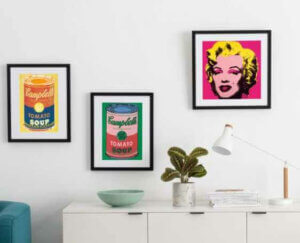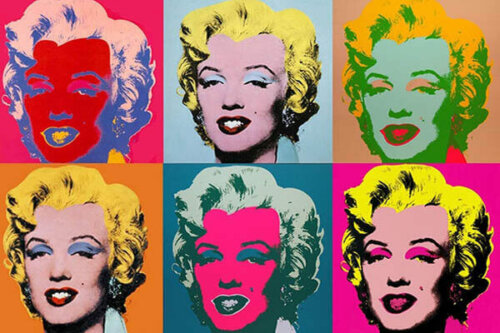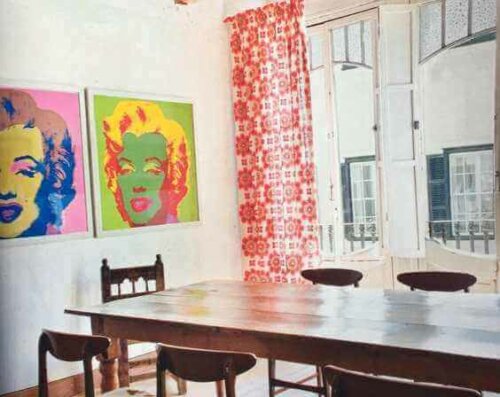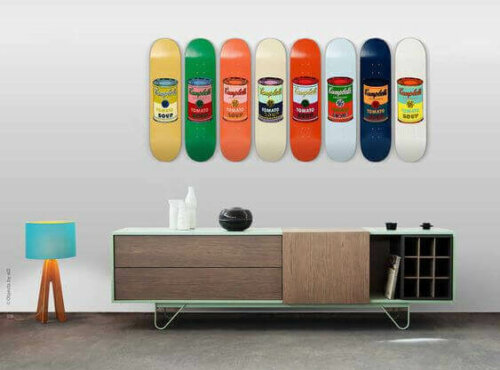Household Items Based on Andy Warhol's Art

You can create sophisticated interiors using resources that offer innovation, elegance, and an attractive look. Therefore, we’re going to look at some household items based on Andy Warhol’s art.
Many people have recognized this artist throughout history for his extravagant personality, way of thinking, and his peculiar image. A simple object, a photograph, or a symbol can become a work of conceptual relevance.
For this reason, his creations have influenced the world of interior design. This is because they offer so many different aesthetic possibilities, such as a certain daring and shamelessness.
Andy Warhol and Pop Art

Warhol is framed in the movement called Pop Art, which emerged from the United Kingdom in the mid-twentieth century. This movement was significant in Europe and North America. In fact, many theorists and specialists recognize it for its groundbreaking and unique style.
From the beginning of his career, Andy Warhol realized that everyday life influences people in a very powerful way. For example, we are used to constantly receiving messages from the products we consume.
In this sense, Warhol uses this idea in his art, using graphic design as the main tool along with vibrant colors. Therefore, if you use a few of his pieces as decoration, they’re sure to bring out a clear, unique character.
Boldness and expressive force are present in his art.
Household items based on Andy Warhol’s art

Some shops specializing in home decoration have replicas of works of art. For example, they have prints or products based on the work of artists like Andy Warhol. Let’s take a look at the 4 best known:
- First of all, we should mention the Marilyn Monroe portrait series. Today, this is an authentic icon representative of Warhol and a point of visual attraction in many rooms. Generally, you can find these prints on canvas.
- The images of Campbell’s Soup cans are also very popular. Warhol’s intention was to fundamentally elevate a consumer product to the level of a work of art. For this, he used commercial illustration as a means of aesthetic expression.
- As for the Brillo boxes, if we analyze the work carefully, this is just a package containing soap sponges. Again, Warhol uses a product that this time acquires the function of a sculpture.
- Warhol also worked on advertisements, such as with Coca-Cola, an internationally-known commercial brand. Through graphic design, he transformed these posters from their original function into a resource for home decoration.
Where to put Andy Warhol’s art

Once you’ve seen some of the ways to incorporate Andy Warhol’s art into your decoration, the question is where to place these pieces. Keep in mind that these are going to be very visually attractive and you don’t want to overload the interior.
For example, one of the images that we mentioned above can look great in a living room. It’s a good focal point that will give the room a modern, original, and avant-garde character.
To create a surprising effect, you can also give your bedroom a pop of personality. However, a great option is to use these pieces in the bathroom to add art to the wall and create a different perception of the space.
The expressive power of colors

One aspect you should take into account is the intensity of color in his work. Therefore, you need to be careful not to overuse these pieces in your decoration. Instead, you should pick the ones that you like the most.
In fact, Andy Warhol typically uses colors that clash with each other. In other words, he doesn’t use complementary colors. This confronts you visually and can be shocking.
In short, his works are a great option to develop the pop art style in your home, but you need to use them carefully and look for unique ways to place them.
You can create sophisticated interiors using resources that offer innovation, elegance, and an attractive look. Therefore, we’re going to look at some household items based on Andy Warhol’s art.
Many people have recognized this artist throughout history for his extravagant personality, way of thinking, and his peculiar image. A simple object, a photograph, or a symbol can become a work of conceptual relevance.
For this reason, his creations have influenced the world of interior design. This is because they offer so many different aesthetic possibilities, such as a certain daring and shamelessness.
Andy Warhol and Pop Art

Warhol is framed in the movement called Pop Art, which emerged from the United Kingdom in the mid-twentieth century. This movement was significant in Europe and North America. In fact, many theorists and specialists recognize it for its groundbreaking and unique style.
From the beginning of his career, Andy Warhol realized that everyday life influences people in a very powerful way. For example, we are used to constantly receiving messages from the products we consume.
In this sense, Warhol uses this idea in his art, using graphic design as the main tool along with vibrant colors. Therefore, if you use a few of his pieces as decoration, they’re sure to bring out a clear, unique character.
Boldness and expressive force are present in his art.
Household items based on Andy Warhol’s art

Some shops specializing in home decoration have replicas of works of art. For example, they have prints or products based on the work of artists like Andy Warhol. Let’s take a look at the 4 best known:
- First of all, we should mention the Marilyn Monroe portrait series. Today, this is an authentic icon representative of Warhol and a point of visual attraction in many rooms. Generally, you can find these prints on canvas.
- The images of Campbell’s Soup cans are also very popular. Warhol’s intention was to fundamentally elevate a consumer product to the level of a work of art. For this, he used commercial illustration as a means of aesthetic expression.
- As for the Brillo boxes, if we analyze the work carefully, this is just a package containing soap sponges. Again, Warhol uses a product that this time acquires the function of a sculpture.
- Warhol also worked on advertisements, such as with Coca-Cola, an internationally-known commercial brand. Through graphic design, he transformed these posters from their original function into a resource for home decoration.
Where to put Andy Warhol’s art

Once you’ve seen some of the ways to incorporate Andy Warhol’s art into your decoration, the question is where to place these pieces. Keep in mind that these are going to be very visually attractive and you don’t want to overload the interior.
For example, one of the images that we mentioned above can look great in a living room. It’s a good focal point that will give the room a modern, original, and avant-garde character.
To create a surprising effect, you can also give your bedroom a pop of personality. However, a great option is to use these pieces in the bathroom to add art to the wall and create a different perception of the space.
The expressive power of colors

One aspect you should take into account is the intensity of color in his work. Therefore, you need to be careful not to overuse these pieces in your decoration. Instead, you should pick the ones that you like the most.
In fact, Andy Warhol typically uses colors that clash with each other. In other words, he doesn’t use complementary colors. This confronts you visually and can be shocking.
In short, his works are a great option to develop the pop art style in your home, but you need to use them carefully and look for unique ways to place them.
All cited sources were thoroughly reviewed by our team to ensure their quality, reliability, currency, and validity. The bibliography of this article was considered reliable and of academic or scientific accuracy.
- Grosenick, Uta; Honnef, Klaus: Pop Art, Taschen, 2004.







